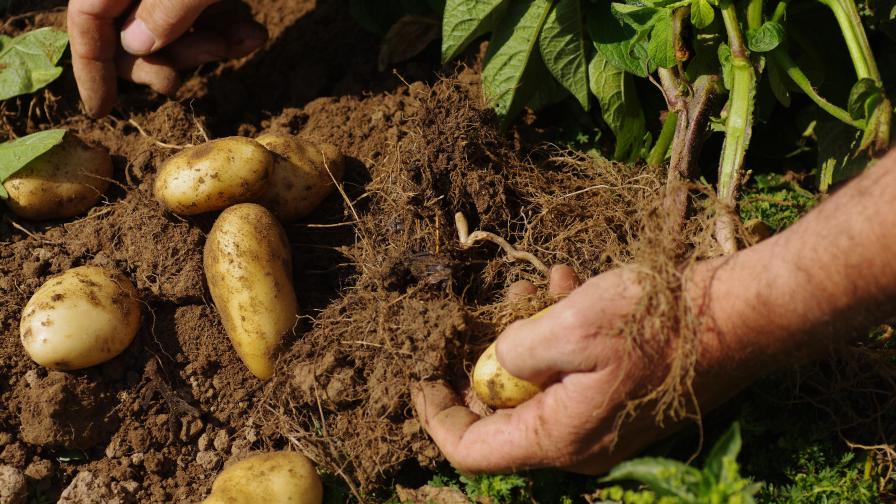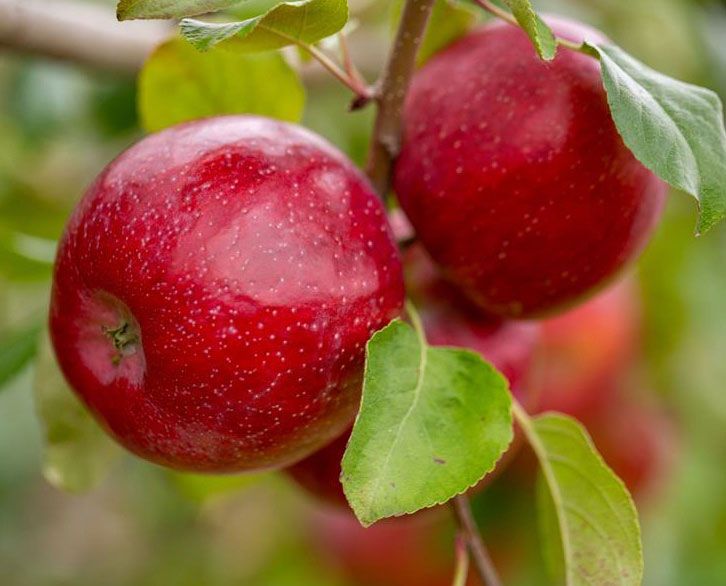All Vines and No Taters? A Potato Grower’s Frustration

To harvest marketable tubers, you need a good balance of leaf and tuber production. Too much of either reduces yield.
Not long ago, my neighbor called me over to discuss the scanty crop of potatoes from his garden this year.
“They looked great all summer, with vigorous and healthy tops,” he said, “but when I dug them there were only a few small tubers.”
The first thing I asked him was whether he had grown them in the ground or in containers. A lot of gardeners grow their potatoes in above-ground containers, but this method can yield poor results when high daytime temperatures warm the soil. Also, high temperatures can promote leaf growth at the expense of tubers.
Needless to say, my neighbor won’t be using containers for his potatoes next year.
It takes leaves to make a potato crop, and maximum yields are achieved when potato plants cover the ground as rapidly as possible. This ensures plants capture the greatest amount of solar energy.
But you must strike the right balance between leaf and tuber growth. Excessive leaf growth can delay tuber initiation and bulking. And if the growing season is too short, much of the energy (carbohydrates) that maintained a big canopy will not end up in the tubers.
On the other hand, anything that restricts the optimal level of canopy growth will result in the plant capturing less energy and limiting the potential yield.
Plant Hormones and Potato Crop Development
Whether carbohydrates are sent to the leaves or tubers depends largely on plant hormones, which regulate all aspects of plant development.
One of the most important hormones for potato production is gibberellic acid (GA). GA promotes leaf growth and stolon elongation. And it has the opposite effect on tuber growth. To initiate tubers, GA levels in the roots and stolons must decrease, while other hormones, especially auxin and abscisic acid (ABA), increase.
Plant hormones are highly responsive to changes in the plant’s environment, including temperature. High temperatures increase GA levels and decrease auxin and ABA levels. Low temperatures have the reverse effect.
Temperature and Crop Development
When I was in graduate school, one of my professors told me about a growth chamber study where potato plants grew at a constant 77°F. The plants produced a healthy canopy but never produced tubers. They needed lower temperatures to induce tuber development.
The optimal temperature for tuber growth is said to be about 59°F, while for leaf it’s about 75°F. A diurnal temperature cycle, with cool nights and warm days, is ideal for potato production.
High temperatures early in the growing season can delay tuber initiation and the onset of rapid tuber bulking while promoting canopy growth. A long delay in tuber development can result in low yields if the crop is harvested early. But it may not be a problem if you can extend the growing season to compensate for the lost time.
Conversely, low temperatures tend to hasten tuber initiation. This can also result in lower yields because the plant must divide its resources to support both leaf and tuber growth over a longer period.
Examples of Timing and Temperature Impacts
Let’s break this down to how timing and high temperatures affect tuber development. High temperatures following tuber initiation can lower yields in two ways:
The rate of photosynthesis results in the plant producing fewer carbohydrates. Photosynthesis in potatoes is optimal at 75°F, decreases rapidly as temperatures rise, and effectively stops at about 86°F.
Heat stress can result in the preferential distribution of carbohydrates to the leaves instead of tubers (the hormone effect described above). In fact, the plant sometimes reabsorbs carbohydrates from tubers to support leaf growth. Extreme heat stress shortly after tuber initiation can even cause some of the tiny tubers to disappear entirely.
Later onset heat stress can result in tuber disorders. The disorder known as “sugar end” or “translucent end” or “jelly end” results when the plant pulls carbohydrates from the stem end of the tuber to support canopy growth after a period of heat stress.
Heat sprouts can occur when heat stress stops tuber development and then the plant produces a sprout at the bud end of the tuber when growth resumes. In this case, plant hormones signal a reversion to vegetative growth.
“All vines and no taters” is a saying from 19th century America that described something or someone who is showy but lacks substance or intelligence. Most people who are familiar with potato production understand the expression. But most of the population nowadays don’t understand its origin and meaning.
Nitrogen and Potato Crop Development
Temperature is not the only factor that affects the partitioning of carbohydrates in potato plants.
High levels of nitrogen fertility can also cause excessive leaf growth at the expense of tubers. So, it should not be surprising to know that nitrogen also influences the levels of plant hormones that regulate tuber growth.
High nitrogen has been associated with increased GA and decreased auxin and ABA. Low nitrogen has the reverse effect.










